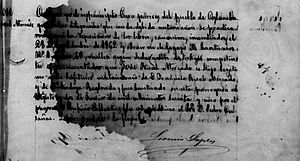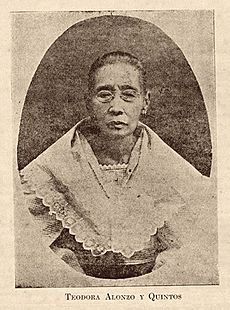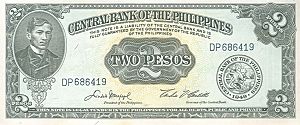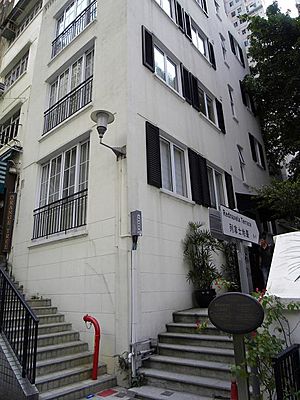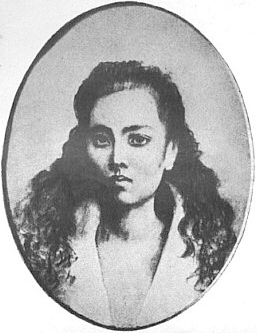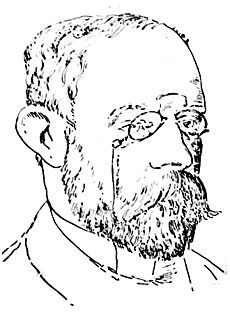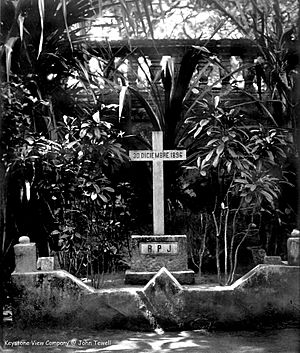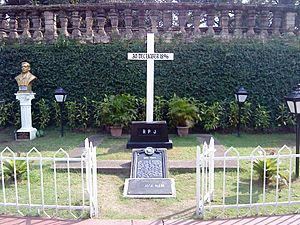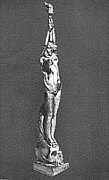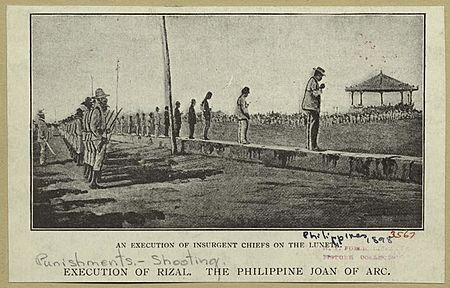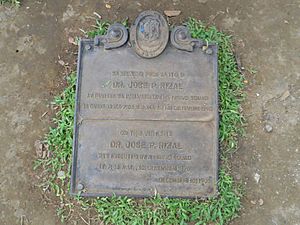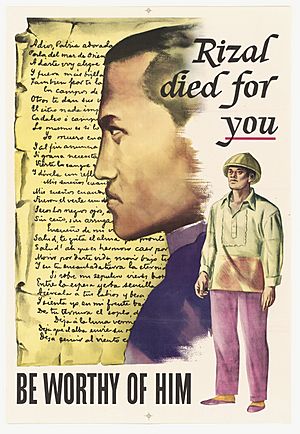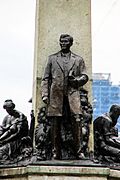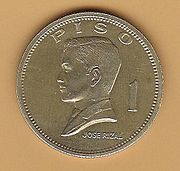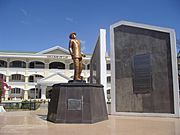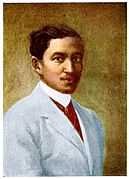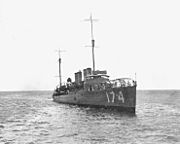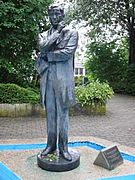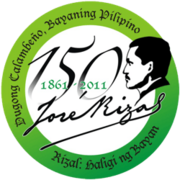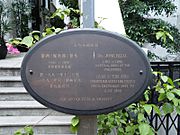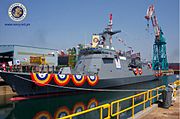José Rizal facts for kids
Quick facts for kids
José Rizal
|
|
|---|---|

Rizal c. 1890s
|
|
| Born |
José Protasio Rizal Mercado y Alonso Realonda
June 19, 1861 |
| Died | December 30, 1896 (aged 35) Bagumbayan, Manila, Captaincy General of the Philippines, Spanish Empire
|
| Cause of death | Execution by firing squad |
| Resting place | Rizal Monument, Manila |
| Monuments |
|
| Other names | Pepe, Jose (nicknames) |
| Alma mater |
|
| Organization | La Solidaridad, La Liga Filipina |
|
Notable work
|
|
| Movement | Propaganda Movement |
| Spouse(s) |
Josephine Bracken
(m. 1896) |
| Parents |
|
| Relatives |
|
| Signature | |
José Protasio Rizal Mercado y Alonso Realonda (Spanish: [xoˈse riˈsal, -ˈθal], Tagalog: [hoˈse ɾiˈsal]; June 19, 1861 – December 30, 1896) was a Filipino nationalist, writer and polymath active at the end of the Spanish colonial period of the Philippines. He is considered the national hero (pambansang bayani) of the Philippines. An ophthalmologist by profession, Rizal became a writer and a key member of the Filipino Propaganda Movement, which advocated political reforms for the colony under Spain.
He was executed by the Spanish colonial government for the crime of rebellion after the Philippine Revolution broke out; it was inspired by his writings. Though he was not actively involved in its planning or conduct, he ultimately approved of its goals which eventually resulted in Philippine independence.
Rizal is widely considered one of the greatest heroes of the Philippines and has been recommended to be so honored by an officially empaneled National Heroes Committee. However, no law, executive order or proclamation has been enacted or issued officially proclaiming any Filipino historical figure as a national hero. He wrote the novels Noli Me Tángere (1887) and El filibusterismo (1891), which together are taken as a national epic, in addition to numerous poems and essays.
Contents
Early life
José Rizal was born on June 19, 1861, to Francisco Rizal Mercado y Alejandro and Teodora Alonso Realonda y Quintos in the town of Calamba in Laguna province. He had nine sisters and one brother. His parents were leaseholders of a hacienda and an accompanying rice farm held by the Dominicans. Both their families had adopted the additional surnames of Rizal and Realonda in 1849, after Governor General Narciso Clavería y Zaldúa decreed the adoption of Spanish surnames among the Filipinos for census purposes (though they already had Spanish names).
Like many families in the Philippines, the Rizals were of mestizo origin. José's patrilineal lineage could be traced to Fujian in China through his father's ancestor Lam-Co, a Hokkien Chinese merchant who immigrated to the Philippines in the late 17th century. Lam-Co traveled to Manila from Xiamen, China, possibly to avoid the famine or plague in his home district, and more probably to escape the Manchu invasion during the Transition from Ming to Qing. He decided to stay in the islands as a farmer. In 1697, to escape the bitter anti-Chinese prejudice that existed in the Philippines, he converted to Catholicism, changed his name to Domingo Mercado and married the daughter of Chinese friend Augustin Chin-co.
On his mother's side, Rizal's ancestry included Chinese and Tagalog. His mother's lineage can be traced to the affluent Florentina family of Chinese mestizo families originating in Baliuag, Bulacan. He also had Spanish ancestry. Regina Ochoa, a grandmother of his mother, Teodora, had mixed Spanish, Chinese and Tagalog blood. His maternal grandfather was a half Spanish engineer named Lorenzo Alberto Alonzo.
From an early age, José showed a precocious intellect. He learned the alphabet from his mother at 3, and could read and write at age 5. Upon enrolling at the Ateneo Municipal de Manila, he dropped the last three names that made up his full name, on the advice of his brother, Paciano and the Mercado family, thus rendering his name as "José Protasio Rizal". Of this, he later wrote: "My family never paid much attention [to our second surname Rizal], but now I had to use it, thus giving me the appearance of an illegitimate child!" This was to enable him to travel freely and disassociate him from his brother, who had gained notoriety with earlier links to Filipino priests Mariano Gomez, Jose Burgos, and Jacinto Zamora (popularly known as Gomburza), who had been accused and executed for treason.

José, as "Rizal", soon distinguished himself in poetry writing contests, impressing his professors with his facility with Castilian and other foreign languages, and later, in writing essays that were critical of the Spanish historical accounts of the pre-colonial Philippine societies. By 1891, the year he finished his second novel El filibusterismo, his second surname had become so well known that, as he writes to another friend, "All my family now carry the name Rizal instead of Mercado because the name Rizal means persecution! Good! I too want to join them and be worthy of this family name..."
Education
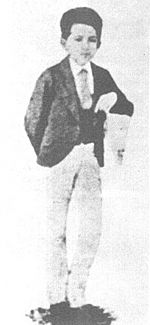
Rizal first studied under Justiniano Aquino Cruz in Biñan, Laguna, before he was sent to Manila. He took the entrance examination to Colegio de San Juan de Letran, as his father requested, but he enrolled at the Ateneo Municipal de Manila. He graduated as one of the nine students in his class declared sobresaliente or outstanding. He continued his education at the Ateneo Municipal de Manila to obtain a land surveyor and assessor's degree, and at the same time at the University of Santo Tomas, where he studied a preparatory course in law and finished with a mark of excelente or excellent. He finished the course of Philosophy as a pre-law.
Upon learning that his mother was going blind, he decided to switch to medicine at the medical school of Santo Tomas, specializing later in ophthalmology. He received his four-year practical training in medicine at Ospital de San Juan de Dios in Intramuros. In his last year at medical school, he received a mark of sobresaliente in courses of Patologia Medica (Medical Pathology), Patología Quirúrgica (Surgical Pathology) and Obstretics.
Although known as a bright student, Rizal had some difficulty in some science subjects in medical school such as Física (Physics) and Patología General (General Pathology).
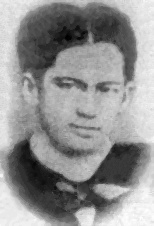
Without his parents' knowledge and consent, but secretly supported by his brother Paciano, he traveled alone to Madrid in May 1882 and studied medicine at the Universidad Central de Madrid. There he earned the degree, Licentiate in Medicine. He also attended medical lectures at the University of Paris and the University of Heidelberg. In Berlin, he was inducted as a member of the Berlin Ethnological Society and the Berlin Anthropological Society under the patronage of the famous pathologist Rudolf Virchow. Following custom, he delivered an address in German in April 1887 before the Anthropological Society on the orthography and structure of the Tagalog language. He wrote a poem to the city, "A las flores del Heidelberg", which was both an evocation and a prayer for the welfare of his native land and the unification of common values between East and West.
At Heidelberg, the 25-year-old Rizal completed his eye specialization in 1887 under the renowned professor, Otto Becker. There he used the newly invented ophthalmoscope (invented by Hermann von Helmholtz) to later operate on his mother's eye. From Heidelberg, Rizal wrote his parents: "I spend half of the day in the study of German and the other half, in the diseases of the eye. Twice a week, I go to the bierbrauerie, or beerhall, to speak German with my student friends." He lived in a Karlstraße boarding house then moved to Ludwigsplatz. There, he met Reverend Karl Ullmer and stayed with them in Wilhelmsfeld. There he wrote the last few chapters of Noli Me Tángere, his first novel, published in Spanish later that year.
Rizal was a polymath, skilled in both science and the arts. He painted, sketched, and made sculptures and woodcarving. He was a prolific poet, essayist, and novelist whose most famous works were his two novels, Noli Me Tángere (1887) and its sequel, El filibusterismo (1891). These social commentaries during the Spanish colonial period of the country formed the nucleus of literature that inspired peaceful reformists and armed revolutionaries alike.
Rizal was also a polyglot, conversant in twenty-two languages.
Rizal's numerous skills and abilities was described by his German friend, Dr. Adolf Bernhard Meyer, as "stupendous." Documented studies show Rizal to be a polymath with the ability to master various skills and subjects. He was an ophthalmologist, sculptor, painter, educator, farmer, historian, playwright and journalist. Besides poetry and creative writing, he dabbled, with varying degrees of expertise, in architecture, cartography, economics, ethnology, anthropology, sociology, dramatics, martial arts, fencing and pistol shooting. Skilled in social settings, he became a Freemason, joining Acacia Lodge No. 9 during his time in Spain; he became a Master Mason in 1884.
Personal life, relationships and ventures
José Rizal's life is one of the most documented of 19th-century Filipinos due to the vast and extensive records written by and about him. Almost everything in his short life is recorded somewhere. He was a regular diarist and prolific letter writer, and much of this material has survived. His biographers have faced challenges in translating his writings because of Rizal's habit of switching from one language to another.
Biographers drew largely from his travel diaries with his comments by a young Asian encountering the West for the first time (other than in Spanish manifestations in the Philippines). These diaries included Rizal's later trips, home and back again to Europe through Japan and the United States, and, finally, through his self-imposed exile in Hong Kong.
Shortly after he graduated from the Ateneo Municipal de Manila (now Ateneo de Manila University), Rizal (who was then 16 years old) and a friend, Mariano Katigbak, visited Rizal's maternal grandmother in Tondo, Manila. Mariano brought along his sister, Segunda Katigbak, a 14-year-old Batangueña from Lipa, Batangas.
His grandmother's guests were mostly college students and they knew that Rizal had skills in painting. They suggested that Rizal should make a portrait of Segunda. He complied reluctantly and made a pencil sketch of her. Rizal who referred to her as his first love in his memoir Memorias de un Estudiante de Manila, but Katigbak was already engaged to Manuel Luz.
From December 1891 to June 1892, Rizal lived with his family in Number 2 of Rednaxela Terrace, Mid-levels, Hong Kong Island. Rizal used 5 D'Aguilar Street, Central district, Hong Kong Island, as his ophthalmology clinic from 2 pm to 6 pm. In this period of his life, he wrote about nine women who have been identified: Gertrude Beckett of Chalcot Crescent, Primrose Hill, Camden, London; wealthy and high-minded Nelly Boustead of an English-Iberian merchant family; Seiko Usui (affectionately called O-Sei-san), last descendant of a noble Japanese family; his earlier friendship with Segunda Katigbak; Leonor Valenzuela, and an eight-year romantic relationship with Leonor Rivera, a distant cousin (she is thought to have inspired his character of María Clara in Noli Me Tángere).
Association with Leonor Rivera
Leonor Rivera is thought to have inspired the character of María Clara in Noli Me Tángere and El Filibusterismo. Rivera and Rizal first met in Manila when Rivera was 14 years old and Rizal was 16. When Rizal left for Europe on May 3, 1882, Rivera was 16 years old. Their correspondence began after Rizal left a poem for her.
Their correspondence helped Rizal stay focused on his studies in Europe. They employed codes in their letters because Rivera's mother did not favor Rizal. In a letter from Mariano Katigbak dated June 27, 1884, she referred to Rivera as Rizal's "betrothed". Katigbak described Rivera as having been greatly affected by Rizal's departure, and frequently sick because of insomnia.
When Rizal returned to the Philippines on August 5, 1887, Rivera and her family had moved back to Dagupan, Pangasinan. Rizal's father forbade the young man to see Rivera in order to avoid putting her family in danger. Rizal was already labeled by the criollo elite as a filibustero or subversive because of his novel Noli Me Tángere. Rizal wanted to marry Rivera while he was still in the Philippines because she had been so faithful to him. Rizal asked permission from his father one more time before his second departure from the Philippines, but he never met her again.
In 1888, Rizal stopped receiving letters from Rivera for a year, although he continued to write to her. Rivera's mother favored an Englishman named Henry Kipping, a railway engineer who fell in love with Rivera. The news of Leonor Rivera's marriage to Kipping devastated Rizal.
His European friends kept almost everything he gave them, including doodlings on pieces of paper. He had visited Spanish liberal, Pedro Ortiga y Pérez, and impressed the man's daughter, Consuelo, who wrote about Rizal. In her diary, she said Rizal had regaled them with his wit, social graces, and sleight-of-hand tricks. In London, during his research on Antonio de Morga's writings, he became a regular guest in the home of Reinhold Rost of the British Museum, who referred to him as "a gem of a man." The family of Karl Ullmer, pastor of Wilhelmsfeld, and the Blumentritts in Germany saved even napkins that Rizal had made sketches and notes on. They were ultimately bequeathed to the Rizal family to form a treasure trove of memorabilia.
Relationship with Josephine Bracken
In February 1895, Rizal, 33, met Josephine Bracken, an Irish woman from Hong Kong. She had accompanied her blind adoptive father, George Taufer, to have his eyes checked by Rizal. After frequent visits, Rizal and Bracken fell in love. They applied to marry but, because of Rizal's reputation from his writings and political stance, the local priest Father Obach would hold the ceremony only if Rizal could get permission from the Bishop of Cebu. As Rizal refused to return to practicing Catholicism, the bishop refused permission for an ecclesiastical marriage.
After accompanying her father to Manila on her return to Hong Kong, and before heading back to Dapitan to live with Rizal, Josephine introduced herself to members of Rizal's family in Manila. His mother suggested a civil marriage, which she believed to be a lesser sacrament but less sinful to Rizal's conscience than making any sort of political retraction in order to gain permission from the Bishop. Rizal and Josephine lived as husband and wife in a common-law marriage in Talisay in Dapitan. The couple had a son, but he lived only a few hours. Rizal named him after his father Francisco.
In Brussels and Spain (1890–1892)
In 1890, Rizal, 29, left Paris for Brussels as he was preparing for the publication of his annotations of Antonio de Morga's Sucesos de las Islas Filipinas (1609). He lived in the boarding house of the sisters, Catherina and Suzanna Jacoby, who had a niece Suzanna ("Thil"), age 16.
Rizal's Brussels stay was short-lived; he moved to Madrid, giving the young Suzanna a box of chocolates. She wrote to him in French: "After your departure, I did not take the chocolate. The box is still intact as on the day of your parting. Don’t delay too long writing us because I wear out the soles of my shoes for running to the mailbox to see if there is a letter from you. There will never be any home in which you are so loved as in that in Brussels, so, you little bad boy, hurry up and come back…" In 2007, Slachmuylders' group arranged for an historical marker honoring Rizal to be placed at the house.
He published Dimanche des Rameaux (Palm Sunday), a socio-political essay, in Berlin on 30 November 1886. Shortly after its publication, Rizal was summoned by the German police, who suspected him of being a French spy.
The content of Rizal's writings changed considerably in his two most famous novels, Noli Me Tángere, published in Berlin in 1887, and El Filibusterismo, published in Ghent in 1891. For the latter, he used funds borrowed from his friends. These writings angered both the Spanish colonial elite and many educated Filipinos due to their symbolism. They are critical of Spanish friars and the power of the Church. Rizal's friend Ferdinand Blumentritt, a professor and historian born in Austria-Hungary, wrote that the novel's characters were drawn from life and that every episode could be repeated on any day in the Philippines.
Blumentritt was the grandson of the Imperial Treasurer at Vienna in the former Austro-Hungarian Empire and a staunch defender of the Catholic faith. This did not dissuade him from writing the preface of El filibusterismo, after he had translated Noli Me Tángere into German. As Blumentritt had warned, these books resulted in Rizal's being prosecuted as the inciter of revolution. He was eventually tried by the military, convicted, and executed. His books were thought to contribute to the Philippine Revolution of 1896, but other forces had also been building for it.
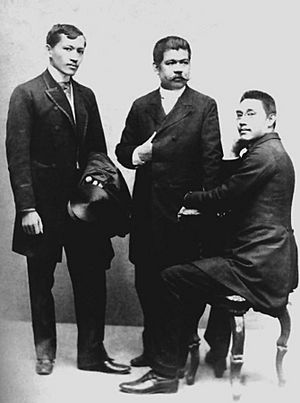
As leader of the reform movement of Filipino students in Spain, Rizal contributed essays, allegories, poems, and editorials to the Spanish newspaper La Solidaridad in Barcelona (in this case Rizal used pen names, "Dimasalang", "Laong Laan" and "May Pagasa"). The core of his writings centers on liberal and progressive ideas of individual rights and freedom; specifically, rights for the Filipino people. He shared the same sentiments with members of the movement: Rizal wrote that the people of the Philippines were battling "a double-faced Goliath"—corrupt friars and bad government. His commentaries reiterate the following agenda:
- That the Philippines be made a province of Spain (The Philippines was a province of New Spain – now Mexico, administered from Mexico City from 1565 to 1821. From 1821 to 1898, it was administered directly from Spain.)
- Representation in the Cortes
- Filipino priests instead of Spanish friars – Augustinians, Dominicans, and Franciscans – in parishes and remote sitios
- Freedom of assembly and speech
- Equal rights before the law (for both Filipino and Spanish plaintiffs)
The colonial authorities in the Philippines did not favor these reforms. Such Spanish intellectuals as Morayta, Unamuno, Pi y Margall, and others did endorse them.
In 1890, a rivalry developed between Rizal and Marcelo H. del Pilar for the leadership of La Solidaridad and the reform movement in Europe. The majority of the expatriates supported the leadership of del Pilar.
Wenceslao Retana, a political commentator in Spain, had slighted Rizal by writing an insulting article in La Epoca, a newspaper in Madrid. He implied that Rizal's family and friends had been evicted from their lands in Calamba for not having paid their due rents. The incident (when Rizal was ten) stemmed from an accusation that Rizal's mother, Teodora, tried to poison the wife of a cousin, but she said she was trying to help. With the approval of the Church prelates, and without a hearing, she was ordered to prison in Santa Cruz in 1871. She was forced to walk the ten miles (16 km) from Calamba. She was released after two-and-a-half years of appeals to the highest court. In 1887, Rizal wrote a petition on behalf of the tenants of Calamba, and later that year led them to speak out against the friars' attempts to raise rent. They initiated litigation that resulted in the Dominicans' evicting them and the Rizal family from their homes. General Valeriano Weyler had the tenant buildings on the farm torn down.
Upon reading the article, Rizal sent a representative to challenge Retana to a duel. Retana published a public apology and later became one of Rizal's biggest admirers. He wrote the most important biography of Rizal, Vida y Escritos del José Rizal.
Return to Philippines (1892–1896)
Exile in Dapitan
Upon his return to Manila in 1892, he formed a civic movement called La Liga Filipina. The league advocated these moderate social reforms through legal means, but was disbanded by the governor. At that time, he had already been declared an enemy of the state by the Spanish authorities because of the publication of his novel.
Rizal was implicated in the activities of the nascent rebellion and in July 1892, was deported to Dapitan in the province of Zamboanga, a peninsula of Mindanao. There he built a school, a hospital and a water supply system, and taught and engaged in farming and horticulture.
The boys' school, which taught in Spanish, and included English as a foreign language (considered a prescient if unusual option then) was conceived by Rizal and antedated Gordonstoun with its aims of inculcating resourcefulness and self-sufficiency in young men. They would later enjoy successful lives as farmers and honest government officials. One, a Muslim, became a datu, and another, José Aseniero, who was with Rizal throughout the life of the school, became Governor of Zamboanga.
In Dapitan, the Jesuits mounted a great effort to secure his return to the fold led by Fray Francisco de Paula Sánchez, his former professor, who failed in his mission. The task was resumed by Fray Pastells, a prominent member of the Order. In a letter to Pastells, Rizal sails close to the deism familiar to us today.
His best friend, professor Ferdinand Blumentritt, kept him in touch with European friends and fellow-scientists who wrote a stream of letters which arrived in Dutch, French, German and English and which baffled the censors, delaying their transmittal. Those four years of his exile coincided with the development of the Philippine Revolution from inception and to its final breakout, which, from the viewpoint of the court which was to try him, suggested his complicity in it. He condemned the uprising, although all the members of the Katipunan had made him their honorary president and had used his name as a cry for war, unity, and liberty.
He is known to making the resolution of bearing personal sacrifice instead of the incoming revolution, believing that a peaceful stand is the best way to avoid further suffering in the country and loss of Filipino lives. In Rizal's own words, "I consider myself happy for being able to suffer a little for a cause which I believe to be sacred [...]. I believe further that in any undertaking, the more one suffers for it, the surer its success. If this be fanaticism may God pardon me, but my poor judgment does not see it as such."
In Dapitan, Rizal wrote "Haec Est Sibylla Cumana", a parlor-game for his students, with questions and answers for which a wooden top was used. In 2004, Jean Paul Verstraeten traced this book and the wooden top, as well as Rizal's personal watch, spoon and salter.
Arrest and trial
By 1896, the rebellion fomented by the Katipunan, a militant secret society, had become a full-blown revolution, proving to be a nationwide uprising. Rizal had earlier volunteered his services as a doctor in Cuba and was given leave by Governor-General Ramón Blanco to serve in Cuba to minister to victims of yellow fever. Rizal and Josephine left Dapitan on August 1, 1896, with letter of recommendation from Blanco.
Rizal was arrested en route to Cuba via Spain and was imprisoned in Barcelona on October 6, 1896. He was sent back the same day to Manila to stand trial as he was implicated in the revolution through his association with members of the Katipunan. During the entire passage, he was unchained, no Spaniard laid a hand on him, and had many opportunities to escape but refused to do so.
While imprisoned in Fort Santiago, he issued a manifesto disavowing the current revolution in its present state and declaring that the education of Filipinos and their achievement of a national identity were prerequisites to freedom.
Rizal was tried before a court-martial for rebellion, sedition and conspiracy, and was convicted on all three charges and sentenced to death. Blanco, who was sympathetic to Rizal, had been forced out of office. The friars, led by then-Archbishop of Manila Bernardino Nozaleda had 'intercalated' Camilo de Polavieja in his stead as the new Spanish Governor-General of the Philippines after pressuring Queen-Regent Maria Cristina of Spain, thus sealing Rizal's fate.
Execution
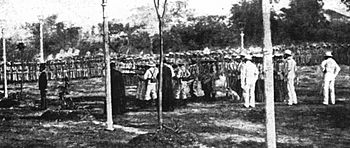
Moments before his execution on December 30, 1896, by a squad of Filipino soldiers of the Spanish Army, a backup force of regular Spanish Army troops stood ready to shoot the executioners should they fail to obey orders. The Spanish Army Surgeon General requested to take his pulse: it was normal. Aware of this the sergeant commanding the backup force hushed his men to silence when they began raising "vivas" with the highly partisan crowd of Peninsular and Mestizo Spaniards. His last words were those of Jesus Christ: "consummatum est" – "it is finished."
A day before, Rizal's mother pleaded with the authorities to have Rizal's body placed under her family's custody as per Rizal's wish; this was unheeded but was later granted by Manuel Luengo, the mayor of Manila. Immediately following the execution, Rizal was secretly buried in Pacò Cemetery (now Paco Park) in Manila with no identification on his grave, intentionally mismarked to mislead and discourage martyrdom.
His undated poem Mi último adiós, believed to have been written a few days before his execution, was later handed to his family with his few remaining possessions, including the final letters and his last bequests.
Rizal's execution, as well as those of other political dissidents (mostly anarchist) in Barcelona was ultimately invoked by Michele Angiolillo, an Italian anarchist, when he assassinated Spanish Prime Minister Antonio Canovas del Castillo.
Exhumation and re-burial
Rizal's sister Narcisa toured all possible gravesites only for her efforts to end in vain. On one day, she visited Paco Cemetery and discovered guards posted at its gate, later finding Luengo, accompanied by two army officers, standing around a freshly-dug grave covered with earth, which she assumed to be that of her brother's, on the reason that there had never been any ground burials at the site. After realizing that Rizal was buried in the spot, she made a gift to the caretaker and requested him to place a marble slab inscribed with "RPJ", Rizal's initials in reverse.
In August 1898, a few days after the Americans took Manila, Narcisa secured the consent of the American authorities to retrieve Rizal’s remains. During the exhumation, it was then revealed that Rizal was not buried in a coffin but was wrapped in cloth before being dumped in the grave; his burial was not on sanctified ground granted to the 'confessed' faithful. The identity of the remains further confirmed by both the black suit and the shoes, both worn by Rizal on his execution, but whatever was in his shoes had disintegrated.
Following the exhumation, the remains were brought to the Rizal household in Binondo, where they were washed and cleaned before being placed in an ivory urn made by Romualdo Teodoro de los Reyes de Jesus. The urn remained in the household until December 28, 1912.
On December 29, the urn was transferred from Binondo to the Marble Hall of the Ayuntamiento, the municipal building, in Intramuros where it remained on public display from 9:00 a.m. to 5:00 p.m., guarded by the Caballeros de Rizal. The public was given the chance to see the urn. The next day, in a solemn procession, the urn began its last journey from the Ayuntamiento to its last resting place in a spot in Bagumbayan (now renamed as Luneta), where the Rizal Monument would be built. Witnessed by his family, Rizal was finally buried in fitting rites. In a simultaneous ceremony, the corner stone for the Rizal monument was placed and the Rizal Monument Commission was created, headed by Tomas G. Del Rosario.
A year later, on 30 December 1913, the monument, designed and made by Swiss sculptor Richard Kissling, was inaugurated.
Works and writings
Rizal wrote mostly in Spanish, the lingua franca of the Spanish East Indies, though some of his letters (for example Sa Mga Kababaihang Taga Malolos) were written in Tagalog. His works have since been translated into a number of languages including Tagalog and English.
Novels and essays
- "El amor patrio", 1882 essay
- "Toast to Juan Luna and Felix Hidalgo", 1884 speech given at Restaurante Ingles, Madrid
- Noli Me Tángere, 1887 novel (literally Latin for 'touch me not', from John 20:17)
- Alin Mang Lahi ("Whate'er the Race"), a Kundiman attributed to Dr. José Rizal
- "Sa Mga Kababaihang Taga-Malolos" (To the Young Women of Malolos), 1889 letter
- Annotations to Antonio de Morga's Sucesos de las Islas Filipinas, 1889
- "Filipinas dentro de cien años" (The Philippines a Century Hence), 1889–90 essay
- "Sobre la indolencia de los filipinos" (The Indolence of Filipinos), 1890 essay
- "Como se gobiernan las Filipinas" (Governing the Philippine islands), 1890 essay
- El filibusterismo, 1891 novel; sequel to Noli Me Tángere
- Una visita del Señor a Filipinas, also known as Friars and Filipinos, 14-page unfinished novel written in 1889
- Memorias de un Gallo, two-page unfinished satire
- Makamisa, unfinished Tagalog-language novel written in 1892
Poetry
- "Felicitación" (1874/75)
- "El embarque" (The Embarkation, 1875)
- "Por la educación recibe lustre la patria" (1876)
- "Un recuerdo á mi pueblo" (1876)
- "Al niño Jesús" (c. 1876)
- "A la juventud filipina" (To the Philippine Youth, 1879)
- "¡Me piden versos!" (1882)
- "Canto de María Clara" (from Noli Me Tángere, 1887)
- "Himno al trabajo" (Dalit sa Paggawa, 1888)
- "Kundiman" (disputed, 1889) - also attributed to Pedro Paterno
- "A mi musa" (To My Muse, 1890)
- "El canto del viajero" (1892–96)
- "Mi retiro" (1895)
- "Mi último adiós" (1896)
- "Mi primera inspiracion" (disputed) - also attributed to Antonio Lopez, Rizal's nephew
Plays
- El Consejo de los Dioses (The Council of Gods)
- Junto al Pasig (Along the Pasig)
- San Euistaquio, Mártyr (Saint Eustache, the Martyr)
Other works
Rizal also tried his hand at painting and sculpture. His most famous sculptural work was The Triumph of Science over Death, a clay sculpture of a young woman with overflowing hair, standing on a skull while bearing a torch held high. The woman symbolized the ignorance of humankind during the Dark Ages, while the torch she bore symbolized the enlightenment science brings over the whole world. He sent the sculpture as a gift to his dear friend Ferdinand Blumentritt, together with another one named The Triumph of Death over Life.
The woman is shown trampling the skull, a symbol of death, to signify the victory the humankind achieved by conquering the bane of death through their scientific advancements. The original sculpture is now displayed at the Rizal Shrine Museum at Fort Santiago in Intramuros, Manila. A large replica, made of concrete, stands in front of Fernando Calderón Hall, the building which houses the College of Medicine of the University of the Philippines Manila along Pedro Gil Street in Ermita, Manila.
Rizal is also noted to be a carver and sculptor who made works from clay, Plaster-of-Paris and baticuling wood, the last being his preferred medium. While in exile in Dapitan, he served as a mentor to three Paete natives including José Caancan, who in turn taught three generations of carvers back in his hometown.
Rizal is known to have made 56 sculptural works, but only 18 of these are known to be still existing as of 2021.
Reactions after death
"Mi último adiós"
The poem is more aptly titled "Adiós, Patria Adorada" (literally "Farewell, Beloved Fatherland"), by virtue of logic and literary tradition, the words coming from the first line of the poem itself. It first appeared in print not in Manila but in Hong Kong in 1897, when a copy of the poem and an accompanying photograph came to J. P. Braga who decided to publish it in a monthly journal he edited. There was a delay when Braga, who greatly admired Rizal, wanted a good facsimile of the photograph and sent it to be engraved in London, a process taking well over two months. It finally appeared under "Mi último pensamiento," a title he supplied and by which it was known for a few years. Thus, the Jesuit Balaguer's anonymous account of the retraction and the marriage to Josephine was published in Barcelona before word of the poem's existence had reached him and he could revise what he had written. His account was too elaborate for Rizal to have had time to write "Adiós."
Six years after his death, when the Philippine Organic Act of 1902 was being debated in the United States Congress, Representative Henry Cooper of Wisconsin rendered an English translation of Rizal's valedictory poem capped by the peroration, "Under what clime or what skies has tyranny claimed a nobler victim?" Subsequently, the US Congress passed the bill into law, which is now known as the Philippine Organic Act of 1902.
This was a major breakthrough for a U.S. Congress that had yet to grant the equal rights to African Americans guaranteed to them in the U.S. Constitution and at a time the Chinese Exclusion Act was still in effect. It created the Philippine legislature, appointed two Filipino delegates to the U.S. Congress, extended the U.S. Bill of Rights to Filipinos and laid the foundation for an autonomous government. The colony was on its way to independence. The United States passed the Jones Law that made the legislature fully autonomous until 1916 but did not recognize Philippine independence until the Treaty of Manila in 1946—fifty years after Rizal's death. This same poem, which has inspired independence activists across the region and beyond, was recited (in its Indonesian translation by Rosihan Anwar) by Indonesian soldiers of independence before going into battle.
Later life of Bracken
Josephine Bracken, whom Rizal addressed as his wife on his last day, promptly joined the revolutionary forces in Cavite province, making her way through thicket and mud across enemy lines, and helped reloading spent cartridges at the arsenal in Imus under the revolutionary General Pantaleón García. Imus came under threat of recapture that the operation was moved, with Bracken, to Maragondon, the mountain redoubt in Cavite.
She witnessed the Tejeros Convention prior to returning to Manila and was summoned by the Governor-General, but owing to her stepfather's American citizenship she could not be forcibly deported. She left voluntarily returning to Hong Kong. She later married another Filipino, Vicente Abad, a mestizo acting as agent for the Tabacalera firm in the Philippines. She died of tuberculosis in Hong Kong on March 15, 1902, and was buried at the Happy Valley Cemetery. She was immortalized by Rizal in the last stanza of Mi Ultimo Adios: "Farewell, sweet stranger, my friend, my joy...".
Polavieja and Blanco
Polavieja faced condemnation by his countrymen after his return to Spain. While visiting Girona, in Catalonia, circulars were distributed among the crowd bearing Rizal's last verses, his portrait, and the charge that Polavieja was responsible for the loss of the Philippines to Spain. Ramon Blanco later presented his sash and sword to the Rizal family as an apology.
Legacy and remembrance
Rizal was a contemporary of Gandhi, Tagore and Sun Yat Sen who also advocated liberty through peaceful means rather than by violent revolution. Coinciding with the appearance of those other leaders, Rizal from an early age had been enunciating in poems, tracts and plays, ideas all his own of modern nationhood as a practical possibility in Asia. In Noli Me Tángere, he stated that if European civilization had nothing better to offer, colonialism in Asia was doomed.
Though popularly mentioned, especially on blogs, there is no evidence to suggest that Gandhi or Nehru may have corresponded with Rizal, nor have they mentioned him in any of their memoirs or letters. But it was documented by Rizal's biographer, Austin Coates who interviewed Jawaharlal Nehru and Gandhi that Rizal was mentioned, specifically in Nehru's prison letters to his daughter Indira.
As a political figure, José Rizal was the founder of La Liga Filipina, a civic organization that subsequently gave birth to the Katipunan led by Andrés Bonifacio,, a secret society which would start the Philippine Revolution against Spain that eventually laid the foundation of the First Philippine Republic under Emilio Aguinaldo. He was a proponent of achieving Philippine self-government peacefully through institutional reform rather than through violent revolution, and would only support "violent means" as a last resort. Rizal believed that the only justification for national liberation and self-government was the restoration of the dignity of the people, saying "Why independence, if the slaves of today will be the tyrants of tomorrow?" However, through careful examination of his works and statements, including Mi Ultimo Adios, Rizal reveals himself as a revolutionary. His image as the Tagalog Christ also intensified early reverence to him.
Rizal, through his reading of Morga and other western historians, knew of the genial image of Spain's early relations with his people. In his writings, he showed the disparity between the early colonialists and those of his day, with the latter's injustices giving rise to Gomburza and the Philippine Revolution of 1896. The English biographer, Austin Coates, and writer, Benedict Anderson, believe that Rizal gave the Philippine revolution a genuinely national character; and that Rizal's patriotism and his standing as one of Asia's first intellectuals have inspired others of the importance of a national identity to nation-building.
The Belgian researcher Jean Paul "JP" Verstraeten authored several books about Jose Rizal: Rizal in Belgium and France, Jose Rizal's Europe, Growing up like Rizal (published by the National Historical Institute and in teacher's programs all over the Philippines), Reminiscences and Travels of Jose Rizal and Jose Rizal "Pearl of Unselfishness". He received an award from the president of the Philippines "in recognition of his unwavering support and commitment to promote the health and education of disadvantaged Filipinos, and his invaluable contribution to engender the teachings and ideals of Dr. Jose Rizal in the Philippines and in Europe". One of the greatest researchers about Rizal nowadays is Lucien Spittael.
Several titles were bestowed on him: "the First Filipino", "Greatest Man of the Brown Race", among others. The Order of the Knights of Rizal, a civic and patriotic organization, boasts of dozens of chapters all over the globe. There are some remote-area religious sects who venerate Rizal as a Folk saint collectively known as the Rizalista religious movements, who claim him as a sublimation of Christ. In September 1903, he was canonized as a saint in the Iglesia Filipina Independiente, however, it was revoked in the 1950s.
Species named after Rizal
José Rizal was imprisoned at Fort Santiago and soon after he was banished at Dapitan where he plunged himself into studying nature. He was then able to collect a number of species of various classes: insects, butterflies, amphibians, reptiles, shells, snakes, and plants.
Rizal sent many specimens of animals, insects, and plants for identification to the (Anthropological and Ethnographical Museum of Dresden), Dresden Museum of Ethnology. It was not in his interest to receive any monetary payment; all he wanted were scientific books, magazines and surgical instruments which he needed and used in Dapitan.
During his exile, Rizal also secretly sent several specimens of flying dragons to Europe. He believed that they were a new species. The German zoologist Benno Wandolleck named them Draco rizali after Rizal. However, it has since been discovered that the species had already been described by the Belgian-British zoologist George Albert Boulenger in 1885 as Draco guentheri.
There are three animal species that Rizal personally collected specimens of, and were posthumously named after him:
- Draco rizali – a small lizard, known as a flying dragon
- Apogonia rizali – a very rare kind of beetle with five horns
- Rhacophorus rizali – a peculiar frog species, now synonymised with Rhacophorus pardalis.
There are also at least five other species discovered afterwards in the Philippines, and explicitly dedicated to his memory:
- Aedes rizali - a mosquito
- Conus rizali - a sea snail
- Hogna rizali - a spider
- Kalayaan rizali - a mite
- Spathomeles rizali - a beetle
Apart from these, entomologist Nathan Banks applied the specific epithet "rizali" to a number of insect species from the Philippines (Chrysopa rizali, Ecnomus rizali, Hemerobius rizali, Hydropsyche rizali, Java rizali, Psocus rizali...), and though he didn't explain the etymology, they were probably intended as a homage to Rizal as well.
Historical commemoration
- Although his field of action lay in politics, Rizal's real interests lay in the arts and sciences, in literature and in his profession as an ophthalmologist. Shortly after his death, the Anthropological Society of Berlin met to honor him with a reading of a German translation of his farewell poem and Dr. Rudolf Virchow delivering the eulogy.
- The Rizal Monument now stands near the place where he fell at the Luneta in Bagumbayan, which is now called Rizal Park, a national park in Manila. The monument, which also contains his remains, was designed by the Swiss Richard Kissling of the William Tell sculpture in Altdorf, Uri. The monument carries the inscription: "I want to show to those who deprive people the right to love of country, that when we know how to sacrifice ourselves for our duties and convictions, death does not matter if one dies for those one loves – for his country and for others dear to him."
- The Taft Commission in June 1901 approved Act 137 renaming the District of Morong into the Province of Rizal. Today, the wide acceptance of Rizal is evidenced by the countless towns, streets, and numerous parks in the Philippines named in his honor.
- Republic Act No. 1425, known as the Rizal Law, was passed in 1956 by the Philippine legislature requiring all high schools and colleges to offer courses about his life, works and writings.
- Monuments erected in his honor can be found in Madrid; Cádiz, Spain; Tokyo; Wilhelmsfeld, Germany; Jinjiang, Fujian, China; Chicago; Jersey City; Cherry Hill Township, New Jersey; Honolulu; San Diego; Los Angeles including the suburbs Carson and West Covina (both near Seafood City); Mexico City; Lima, Peru; Litomerice, Czech Republic; Toronto; Markham; and Montreal, Quebec, Canada.
- A two-sided marker bearing a painting of Rizal by Fabián de la Rosa on one side and a bronze bust relief of him by Philippine artist Guillermo Tolentino stands at the Asian Civilisations Museum Green marking his visits to Singapore in 1882, 1887, 1891 and 1896.
- A Rizal bronze bust was erected at La Molina district, Lima, Peru, designed by Czech sculptor Hanstroff, mounted atop a pedestal base with four inaugural plaque markers with the following inscription on one: "Dr. José P. Rizal, Héroe Nacional de Filipinas, Nacionalista, Reformador Political, Escritor, Lingüistica y Poeta, 1861–1896."
- A Rizal bust sits in front of the Filipino American Council of Chicago, celebrating a one-day visit Dr. Rizal made to Chicago on May 11, 1888, as seen below.
- A plaque marks the Wilhelmsfeld building where he trained with Professor Becker. There is a small park in Wilhelmsfeld named after Rizal with a bronze statue of Rizal, and the street where he lived on was also renamed after him. Wilhelmsfeld's local government gifted the sandstone fountain in Pastor Ullmer's house garden where Rizal lived to the Philippine government and is now located at Rizal Park in Manila.
- In Heidelberg, a small stretch along the Neckar River is named after Rizal. In 2014, a commemorative sandstone plaque was placed there in Rizal's honor.
- Throughout 2011, the National Historical Institute and other institutions organized several activities commemorating the 150th birth anniversary of Rizal, which took place on June 19 of that year.
- The London Borough of Camden placed a Blue Plaque at 37 Chalcot Crescent, where Rizal lived for some time, with the words: "Dr. José Rizal, Writer and National Hero of the Philippines".
- A monument in honor of Rizal was planned, and built in Rome.
- In the City of Philadelphia, the 'City of Murals' first Filipino mural in the US east coast honoring José Rizal was to unveiled to the public in time for Rizal's Sesquicentennial year-long celebration.
- The Grand Oriental Hotel in Colombo, Sri Lanka has a suite named after Jose P. Rizal as he had stayed there in May 1882.
- The USS Rizal (DD-174) was a Wickes-class destroyer named after Rizal by the United States Navy and launched on September 21, 1918.
- The José Rizal Bridge and Rizal Park in the city of Seattle are dedicated to Rizal.
- On 19 June 2019, on Rizal's 158th birthday, he was honored with a Google Doodle.
- A bronze bust of Rizal by F.B. Case was gifted to the City of Toronto by the Government of the Philippines in 1998. It is located at Earl Bales Park in the neighborhood of Lansing.
- A monument by Mogi Mogado was unveiled at Luneta Gardens (a similar name as that of the park where Rizal is buried—Luneta Park or now as Rizal Park) in 2019 as a gift from the Filipino Canadian community of Markham to the City of Markham. It is located in the Box Grove area of Markham, Ontario, near Rizal Avenue, which is also named for him.
- A Jose Rizal-class frigate of the Philippine Navy was built by Hyundai Heavy Industries. Two ships were ordered in 2016. They are the first guided missile frigate to enter service with the Philippine Navy. The lead ship, BRP Jose Rizal, arrived in the Philippines on May 22, 2020.
-
Rizal on the obverse side of a 1970 Philippine peso coin
-
The Portrait of Rizal, painted in oil by Juan Luna
See also
 In Spanish: José Rizal para niños
In Spanish: José Rizal para niños
- José Martí, Cuban national hero also executed by the Spanish in 1895


